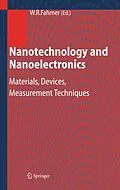This book provides a concise and didactically structured presentation of nanotechnology as matters stand. Both students and engineers can gain valuable insights into the historical development, production, and characterization procedures of structures in the nanometer range, their electrical applications, measuring procedures for the determination of nanodefect, nanolayer, and nanoparticle characteristics, and the major techniques of preparation in nanotechnology. Based on known facts, an evaluation of nanotechnology, its further development, and its future prospects are attempted.
Wolfgang Fahrner (*1945) received his education in Freiburg and Darmstadt, Germany, and in Montpellier (France). He was awarded a doctorate for his thesis on "Ion implantation in MOS". His research includes measurement of minority carrier lifetimes (IBM East Fishkill), passivation of power devices and secondary ion mass spectroscopy (Fraunhofer Society), and radiation damage in semiconductors (Hahn-Meitner Institute, Berlin). In 1981, Prof. Fahrner obtained his postdoctoral qualification at Berlin Technical University's Department of Electrical Engineering. In 1986, he was appointed associate professor and in 1988, he was offered the Chair of Electronic Devices at Hagen University. Prof. Fahrner is a member of the Electrochemical Society, DPG, IEEE Senior Member, and has initiated the "Nanotechnology Cooperation NRW".
Zusammenfassung
Split a human hair thirty thousand times, and you have the equivalent of a nanometer. The aim of this work is to provide an introduction into nanotechnology for the s- entifically interested. However, such an enterprise requires a balance between comprehensibility and scientific accuracy. In case of doubt, preference is given to the latter. Much more than in microtechnology whose fundamentals we assume to be known a certain range of engineering and natural sciences are interwoven in nanotechnology. For instance, newly developed tools from mechanical engine- ing are essential in the production of nanoelectronic structures. Vice versa, - chanical shifts in the nanometer range demand piezoelectric-operated actuators. Therefore, special attention is given to a comprehensive presentation of the matter. In our time, it is no longer sufficient to simply explain how an electronic device operates; the materials and procedures used for its production and the measuring instruments used for its characterization are equally important. The main chapters as well as several important sections in this book end in an evaluation of future prospects. Unfortunately, this way of separating coherent - scription from reflection and speculation could not be strictly maintained. So- times, the complete description of a device calls for discussion of its inherent - tential; the hasty reader in search of the general perspective is therefore advised to study this work's technical chapters as well.
Inhalt
Historical Development.- Quantum Mechanical Aspects.- Nanodefects.- Nanolayers.- Nanoparticles.- Selected Solid States with Nanocrystalline Structures.- Nanostructuring.- Extension of Conventional Devices by Nanotechniques.- Innovative Electronic Devices Based on Nanostructures.
